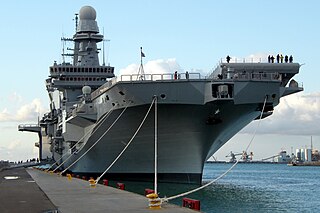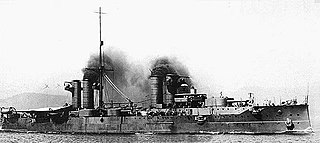
A carrier battle group (CVBG) is a naval fleet consisting of an aircraft carrier capital ship and its large number of escorts, together defining the group. The CV in CVBG is the United States Navy hull classification code for an aircraft carrier.

Giuseppe Garibaldi is an Italian aircraft carrier, the first through-deck aviation ship ever built for the Italian Navy, and the first Italian ship built to operate fixed-wing aircraft. Although she is widely recognised as a carrier first and foremost, she is officially designated as an aircraft-carrying cruiser. She is equipped with short take-off and vertical landing (STOVL) aircraft and helicopters. Giuseppe Garibaldi was involved in combat air operations off Somalia, Kosovo, Afghanistan and Libya.

Cavour is an Italian aircraft carrier launched in 2004. She is the flagship of the Italian Navy.

The Italian Navy is one of the four branches of Italian Armed Forces and was formed in 1946 from what remained of the Regia Marina after World War II. As of August 2014, the Italian Navy had a strength of 30,923 active personnel, with approximately 184 vessels in service, including minor auxiliary vessels. It is considered a multiregional and a blue-water navy.

The Galicia class are two landing platform dock (LPD) ships in service with the Spanish Navy. Built by Navantia at Ferrol, their mission is to carry out amphibious warfare by transporting the bulk of the Infantería de Marina. These ships have both a large helicopter flight deck and a 885-square-metre (9,530 sq ft) well deck for large landing craft, as well as a 1,000-square-metre (11,000 sq ft) space for up to 33 main battle tanks.

The Spanish–Italian Amphibious Battlegroup is one of 18 European Union battlegroups. It is formed by the Spanish–Italian Landing Force (SILF) of the Spanish–Italian Amphibious Force. It consists of 1500 Marines with manpower contributed from the participating countries. From January until June 2009, it was on the EU Battlegroup standby roster.

The San Giorgio class are amphibious transport docks (LPD) built by Fincantieri for the Italian Navy. These ships can carry a battalion of troops, and up to 36 armored vehicles. The stern floodable dock can accommodate three landing craft. The ships are based at the Brindisi naval base on the Adriatic coast.

Operation Atalanta, formally European Union Naval ForceSomalia, is an ongoing counter-piracy military operation at sea off the Horn of Africa and in the Western Indian Ocean, that is the first naval operation conducted by the European Union (EU), in support of United Nations resolutions 1814, 1816, 1838, and 1846 adopted in 2008 by the United Nations Security Council. Since 29 March 2019, the operational headquarters is located at Naval Station Rota in Spain, having moved from London as a result of the British withdrawal from the EU.

San Giusto is a San Giorgio-class amphibious transport dock of the Italian Navy. The ship was built by Fincantieri-Cantieri Navali SpA at Riva Trigoso, laid down on 19 August 1991, and launched on 23 October 1993.

Operation Unified Protector was a NATO operation in 2011 enforcing United Nations Security Council resolutions 1970 and 1973 concerning the Libyan Civil War and adopted on 26 February and 17 March 2011, respectively. These resolutions imposed sanctions on key members of the Gaddafi government and authorized NATO to implement an arms embargo, a no-fly zone and to use all means necessary, short of foreign occupation, to protect Libyan civilians and civilian populated areas.

The Italian cruiser San Marco was a San Giorgio-class armoured cruiser built for the Royal Italian Navy in the first decade of the 20th century. She was the first large Italian ship fitted with steam turbines and the first turbine-powered ship in any navy to have four propeller shafts. The ship participated in the Italo-Turkish War of 1911–1912, during which time she supported the occupations of Benghazi and Derna, the island of Rhodes, and bombarded the fortifications defending the entrance to the Dardanelles. During World War I, San Marco's activities were limited by the threat of Austro-Hungarian submarines, although the ship did participate in the bombardment of Durazzo, Albania in late 1918. She played a minor role in the Corfu incident in 1923 and was converted into a target ship in the first half of the 1930s. San Marco was captured by the Germans when they occupied northern Italy in 1943 and was found sunk at the end of the war. The ship was broken up and scrapped in 1949.

The "San Marco" Marine Brigade is an amphibious formation of the Italian Navy, has been brigade since 2013 but the amphibious corps existed since 1915, reorganizing the Navy Landing Force. It has its command in Brindisi. They are the marines of the Italian Navy.

The San Giorgio class consisted of two armored cruisers built for the Royal Italian Navy in the first decade of the 20th century. The second ship, San Marco, was used to evaluate recently invented steam turbines in a large ship and incorporated a number of other technological advances. The ships participated in the Italo-Turkish War of 1911–1912, although San Giorgio was under repair for most of the war. San Marco supported ground forces in Libya with naval gunfire and helped them to occupy towns in Libya and islands in the Dodecanese. During World War I, the ships' activities were limited by the threat of Austro-Hungarian submarines, although they did bombard Durazzo, Albania in 1918.
Operation Mare Nostrum was a year-long naval and air operation commenced by the Italian government on 18 October 2013, which rescued at least 150,000 migrants on the dangerous Mediterranean sea crossing. The operation ended on 31 October 2014, and was superseded by Frontex's Operation Triton.

Operation Sophia, formally European Union Naval Force Mediterranean, was a military operation of the European Union that was established as a consequence of the April 2015 Libya migrant shipwrecks with the aim of neutralising established refugee smuggling routes in the Mediterranean. The operational headquarters was located in Rome. The EU mandate for the operation ended on March 31, 2020. Operation Irini is the successor operation.

Kalaat Beni Abbes (L-474) is an amphibious transport dock of the Algerian National Navy. The ship built by the Italian firm Fincantieri as an enlarged and improved version of the San Giorgio class. The ship measures 143 metres (469 ft) long and 21.5 metres (71 ft) wide.

Ascari was one of nineteen Soldati-class destroyers built for the Regia Marina in the late 1930s and early 1940s. Completed in mid-1939, she was the last of the first batch of a dozen ships to enter service.
The following is the structure of the Italian Navy as of June 2020. It is considered a multiregional and a blue-water navy.

San Marco is the second ship of the San Giorgio-class landing platform dock of the Italian Navy.

Al Fulk (L141) is an amphibious transport dock of the Qatari Emiri Navy.


















